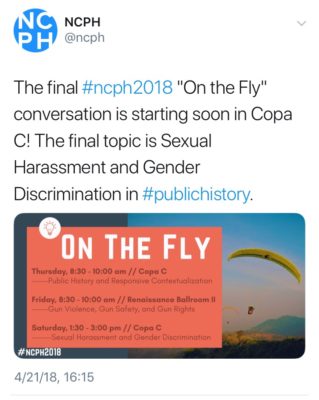Sexual harassment and gender discrimination in public history
14 August 2018 – Mary Rizzo

Mary Rizzo. Photo credit: Mary Rizzo.
I was a nineteen-year-old intern at a nonprofit organization working on educational programs. My direct supervisor was a man in his 30s. We shared an office, which meant it was hard to avoid his flirtatious comments, like when he asked me to “try out some mattresses with him.” When my internship ended, he took me out to what I thought was a thank you dinner for the work I had done during my internship year. Instead, he propositioned me. I refused and brushed these experiences aside. After all, it was the 1990s. I could handle myself. Looking back decades later, as we are in the midst of a public discussion about sexual harassment and gender discrimination in the workplace, I see how inappropriate he was and how he capitalized on my lack of professional employment experience. He knew, intuitively, that I would not slap him or file a complaint with the executive director. I wouldn’t even know that I had these options. As I would learn throughout my career, these kinds of advances were shockingly common. Equally common, were other kinds of sexual harassment and gender discrimination I experienced or heard about from friends—being passed over for promotions, left out of important meetings, treated as an object rather than person, and so on.
NCPH’s Diversity and Inclusion Task Force (DITF) is addressing the issue of sexual harassment and gender discrimination in public history. Sexual harassment and gender discrimination disempowers and marginalizes women and men of all races, gender identities, and sexual orientations. They are also violations of workers’ rights. Public historians have been advocates for more equitable working conditions in a variety of ways, including paid internships and more support for people of color in predominantly white institutions. Ending sexual harassment and gender discrimination is an equally critical part of our efforts to diversify our field.
According to a Marist poll from 2017, 22% of adults in the United States and 35% of women have experienced sexual harassment at work. While public historians may think of their work as a calling or a kind of public service, they are also workers who are in need of protections. Women, people of color, and LGBTQ and gender non-binary people are at greater risk of harassment and discrimination in any field, including public history. Allowing harassment and discrimination to continue shows these groups that they are powerless and not really welcome in our field, no matter what our rhetoric of diversity and inclusion may say.

Advertisement for the On the Fly session at the 2018 NCPH Annual Meeting. Image credit: NCPH
The DITF held an “On The Fly” session on sexual harassment and gender discrimination in public history at the 2018 NCPH annual meeting. We asked participants to tell their own stories on sticky notes that we exhibited throughout the room. We also included stories submitted through an online survey. These excerpts, in people’s own words, give a sense of how, where, and when public historians experience harassment and discrimination:
I was finishing up in my final year of grad-school. I was on the hunt for jobs and had been recommended to a local museum as a potential contractor for a major grant-funded digitization project. Working with a contract archivist, we started working on imaging. Soon it became clear that this archivist was “old school” as he liked to call it. He was proud that he had never taken any of “that sensitivity training shit.” He would print test runs of the images we were digitizing, typically choosing ones of 1940s young women modelling on top of cars. He always commented on their looks and legs. I didn’t think much of it at first, but soon we started getting other interns—female interns. He confided in me that he felt women had a better attention to detail than the men, so he always hired women. Things started to get worse when he would talk about the other women who worked in other collections departments. He usually referred to them as “these bitches”. . .The big doozy was when I got a message asking if I’d like to go to Cuba with him, and drink—naked on the beach. At first I couldn’t believe what I was reading. But then I started thinking about how I was the same age as his daughter. He never messaged me again with anything that shocking. But he did continue right up until I announced my first pregnancy with my husband.
So many stories! I was at a historical reenactment and one of the reenactors commented on my breasts. While using the copier in the history department, an older male professor assumed I was the new secretary. A female boss told me I was too nice to be a director. On and on.
Being misgendered. Getting hit on my project members/participants (ex. oral history narrators).
Told not to get pregnant as it would be inconvenient. Comments about physical appearance, life/family planning.
30 years ago, I had an unpaid internship at a state historical society and historic house. Housing was provided with the director and his family in exchange for babysitting. Toward the end of my stay, the Director made a pass at me. I left the internship abruptly and early, not getting to finish the research project I’d been working on all summer. I told my friend (who picked me up because I didn’t have a car), but as far as I can remember no one else.
Older man at NCPH conference commenting to me over lunch about how good-looking other people at this conference are. . .awkward and uncomfortable.
Many years ago, I helped a student get a job with a well-known person in the field, someone whose work I admire. Very recently the former student shared with me, in confidence, that this person had engaged in sexually inappropriate behavior in the workplace. Not I’m not sure whether to cut ties with this person and, if so, to tell him why.
We can add the stories of sexual assault, harassment, and intimidation experienced by women working for the National Park Service. Reports found that more than half of all women employed by NPS as rangers and three-quarters employed as park police had experienced sexual assault, harassment, intimidation, and a hostile work environment.
#MeToo and #TimesUp have forced many industries to look hard at their workplace cultures and procedures for handling these incidents. While we can learn from what others are doing, public historians need to rigorously examine the unique structures in our field that allow harassment to occur.
Through our discussion, we identified five ways that the structure of public history workplaces can allow or exacerbate sexual harassment and gender discrimination:
- Isolation. Many public history jobs are isolated, with people working by themselves or in small organizations that may not have a human relations person on staff. Isolation creates opportunities for predators and harassers. It presents challenges when confronting sexual harassment and gender discrimination.
- Gender and racial disparity. Public history institutions are often led by men, but staffed by women. This gendered imbalance of power can create conditions for harassment and discrimination. For people of color, the situation is compounded as they may be the only person of color in an otherwise white institution. It’s important to remember that while women experience the majority of sexual harassment, men can also be victims.
- Close working relationships. Building close relationships with community partners and others is a key task for public historians. The emphasis on relationships may deter some from reporting sexual harassment and gender discrimination because they don’t want to damage relationships that took time and resources to develop.
- Job insecurity. People in the early stage of their careers are often under specific pressures that may deter them from reporting or speaking out about sexual harassment and gender discrimination. For example, they may not be familiar with the norms of workplaces and may not be aware of what they should expect from an employer. There is so much competition for the few jobs available that people may not report harassment or discrimination out of fear that they will never find another job.
- Interacting with the public. Front-line public history workers can experience sexual harassment and gender discrimination from members of the public in the course of their job.
As a start to a longer conversation, the DITF has issued a report to the NCPH Board, which includes short and long-term recommendations based on the survey and session feedback. The NCPH office staff and board are reviewing the report and are making progress towards some of the recommendations already. They are prepared to support the DITF and its recommendations. Our goal is not to minimize the risk of litigation for institutions, but to protect and support public historians at all stages of their careers so that we can continue our efforts for inclusive, safe workplaces. There will be opportunities for NCPH members to be involved in the shaping of policy. If you have questions or suggestions, please note them in the comments below, or contact the Diversity and Inclusion Task Force through NCPH.
If you have experienced or are experiencing sexual harassment or gender discrimination at work, or have been a victim of sexual violence, you may want to refer to the Me Too Movement Resource page: https://metoomvmt.org/resources.
Do you have a story of sexual harassment or gender discrimination as a public historian that you’d like to share? You may add it anonymously to the Diversity and Inclusion Task Force’s survey.
~ Mary Rizzo is assistant professor in history and associate director of the graduate program in American Studies at Rutgers University-Newark. A member of the NCPH’s Diversity and Inclusion Task Force, she has worked on inclusive public history projects, including creating New Jersey’s annual Telling Untold Histories unconference and the Chicory digital archive of African American poetry. She tweets as @rizzo_pubhist.



